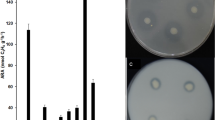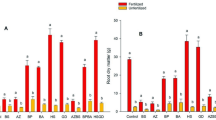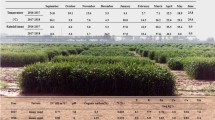Abstract
Acquisition of nutrients by plants is primarily dependent on root growth and bioavailability of nutrients in the rooting medium. Most of the beneficial bacteria enhance root growth, but their effectiveness could be influenced by the nutrient status around the roots. In this study, two 1-aminocyclopropane-1-carboxylate (ACC)-deaminase containing plant-growth-promoting rhizobacteria (PGPR), Pseudomonas fluorescens and P. fluorescens biotype F were tested for their effect on growth, yield, and nutrient use efficiency of wheat under simultaneously varying levels of all the three major nutrients N, P, and K (at 0%, 25%, 50%, 75%, and 100% of recommended doses). Results of pot and field trials revealed that the efficacy of these strains for improving growth and yield of wheat reduced with the increasing rates of NPK added to the soil. In most of the cases, significant negative linear correlations were recorded between percentage increases in growth and yield parameters of wheat caused by inoculation and increasing levels of applied NPK fertilizers. It is highly likely that under low fertilizer application, the ACC-deaminase activity of PGPR might have caused reduction in the synthesis of stress (nutrient)-induced inhibitory levels of ethylene in the roots through ACC hydrolysis into NH3 and α-ketobutyrate. The results of this study imply that these Pseudomonads could be employed in combination with appropriate doses of fertilizers for better plant growth and savings of fertilizers.


Similar content being viewed by others
References
Abeles FB, Morgan PW, Saltveit ME Jr (1992) Ethylene in plant biology. Academic, San Diego, CA
Arshad M, Frankenberger WT Jr (1998) Plant-growth regulating substances in the rhizosphere: Microbial production and functions. Adv Agron 62:45–151
Arshad M, Frankenberger WT Jr (2002) Ethylene: agricultural sources and applications. Kluwer, New York
Ayers RS, Westcot DW (1985) Water quality for agriculture. FAO Irrigation and Drainage Papers 29 (Rev. 1) FAO, Rome
Barber SA, Cushman JH (1981) Nitrogen uptake model for agronomic crops. In: Iskander IK (ed) Modeling wastewater renovation-land treatment. Wiley-Interscience, New York, pp 382–409
Barber SA, Silverbush M (1984) Plant root morphology and nutrient uptake. In: Barber SA, Bouldin DR, Kral DM, Hawkins SL (eds) Roots, nutrient and water influx and plant growth. ASA special publication number 49. American Society of Agronomy, Madison, WI, pp 65–88
Barker A, Corey K (1990) Ethylene evolution by tomato plants receiving nitrogen nutrition from urea. Hortic Sci 119:706–710
Burd GI, Dixon DG, Glick BR (1998) A plant growth promoting bacteria that decreases nickel toxicity in seedlings. Appl Environ Microbiol 64:3663–3668
Corey K, Barker A (1989) Ethylene evolution and polyamine accumulation by tomato subjected to interactive stresses of ammonium toxicity and potassium deficiency. J Am Soc Hortic Sci 114:651–655
De Freitas JR, Germida JJ (1990) Plant growth promoting rhizobacteria for winter wheat. Can J Microbiol 36:265–272
Dworkin M, Foster J (1958) Experiments with some microorganisms which utilize ethane and hydrogen. J Bacteriol 75:592–601
German MA, Burdman S, Okon Y, Kigel J (2000) Effects of Azospirillum brasilense on root morphology of common bean (Phaseolus vulgaris L.) under different water regimes. Biol Fertil Soils 32:259–264
Glick BR (2004) Changes in plant growth and development by rhizosphere bacteria that modify plant ethylene levels. Acta Horticult 631:265–273
Glick BR, Karaturovic DM, Newell PC (1995) A novel procedure for rapid isolation of plant growth promoting pseudomonads. Can J Microbiol 41:533–536
Glick BR, Penrose DM, Li J (1998) A model for the lowering of plant ethylene concentrations by plant growth-promoting bacteria. J Theor Biol 190:63–68
Grichko VP, Glick BR (2001) Amelioration of flooding stress by ACC deaminase-containing plant growth-promoting bacteria. Can J Microbiol 47:77–80
Holguin G, Glick BR (2001) Expression of the ACC deaminase gene from Enterobacter cloacae UW4 in Azospirillum brasilense. Microb Ecol 41:281–288
Johnson PR, Ecker JR (1998) The ethylene gas signal transduction pathway: a molecular perspective. Annu Rev Genet 32:227–254
Karlidag H, Esitken A, Turan M, Sahin F (2007) Effects of root inoculation of plant growth promoting rhizobacteria (PGPR) on yield, growth and nutrient element contents of leaves of apple. Sci Hortic 114:16–20
Kende H (1993) Ethylene biosynthesis. Annu Rev Plant Physiol Plant Mol Biol 44:283–307
Khalid A, Arshad M, Zahir ZA (2004) Screening plant growth-promoting rhizobacteria for improving growth and yield of wheat. J Appl Microbiol 96:473–480
Lucy M, Reed E, Glick BR (2004) Application of free living plant growth-promoting rhizobacteria. Antonie van Leeuwenhoek 86:1–25
Lynch J, Brown KM (1997) Ethylene and plant responses to nutritional stress. Physiol Plant 100:613–619
Marshner H (1995) Mineral nutrition of higher plants. Academic, London
Mattoo AK, Suttle CS (1991) The plant hormone ethylene. CRC, Boca Raton, FL
Mayak S, Tirosh T, Glick BR (2004a) Plant growth-promoting bacteria confer resistance in tomato plants to salt stress. Plant Physiol Biochem 42:565–572
Mayak S, Tirosh T, Glick BR (2004b) Plant growth-promoting bacteria that confer resistance to water stress in tomato and pepper. Plant Sci 166:525–530
Morgan PG, Drew MC (1997) Ethylene and plant responses to stress. Physiol Plant 100:620–630
Penrose D, Glick BR (2001) Levels of 1-aminocyclopropane-1-carboxylic acid (ACC) in exudates and extracts of canola seeds treated with plant growth-promoting bacteria. Can J Microbiol 47:368–372
Reid MS (1995) Ethylene in plant growth, development and senescence. In: Davies PJ (ed) Plant hormone, physiology, biochemistry and molecular biology. Kluwer, Dordrecht Netherlands, pp 486–508
Rengel Z, Kordan H (1988) Effect of N, P and K deficiencies on light-dependent anthocyanin formation in Zea mays L. seedlings. J Plant Physiol 132:126–128
Ryan J, Estefan G, Rashid A (2001) Soil and plant analysis: laboratory manual. ICARDA, Aleppo
Saleem M, Arshad M, Hussain S, Bhatti AS (2007) Perspectives of plant growth promoting rhizobacteria (PGPR) containing ACC deaminase in stress agriculture. J Ind Microbiol Biotech 34:635–648
Salisbury FB (1994) The role of plant hormones. In: Wilkinson RE (ed) Plant–environment interactions. Marcel Dekker, New York, USA, pp 39–81
Shaharoona B, Arshad M, Zahir ZA (2006a) Effect of plant growth promoting rhizobacteria containing ACC-deaminase on maize (Zea mays L.) growth under axenic conditions and on nodulation in mung bean (Vigna radiata L.). Lett Appl Microbiol 42:155–159
Shaharoona B, Arshad M, Zahir ZA, Khalid A (2006b) Performance of Pseudomonas spp. containing ACC-deaminase for improving growth and yield of maize (Zea mays L.) in the presence of nitrogenous fertilizer. Soil Biol Biochem 38:2971–2975
Shaharoona B, Bibi R, Arshad M, Zahir ZA, Hassan Z (2006c) 1-Aminocylopropane-1-carboxylate (ACC)-deaminase rhizobacteria extenuates ACC-induced classical triple response in etiolated pea seedlings. Pak J Bot 38:1491–1499
Shaharoona B, Jamro GM, Zahir ZA, Arshad M, Memon KS (2007a) Effectiveness of various Pseudomonas spp. and Burkholderia caryophylli containing ACC-deaminase for improving growth and yield of wheat (Triticum aestivum l.). J Microbiol Biotechnol 17:1300–1307
Shaharoona B, Arshad M, Khalid A (2007b) Differential response of etiolated pea seedling to 1-aminocyclopropane-1-carboxylate and/or l-methionine utilizing rhizobacteria. J Micrbiol 45:15–20
Vessay JK (2003) Plant growth promoting rhizobacteria as biofertilizers. Plant soil 255:571–586
Zahir ZA, Arshad M, Frankenberger WT Jr (2004) Plant growth promoting rhizobacteria application and perspectives in agriculture. Adv Agron 81:97–168
Author information
Authors and Affiliations
Corresponding author
Rights and permissions
About this article
Cite this article
Shaharoona, B., Naveed, M., Arshad, M. et al. Fertilizer-dependent efficiency of Pseudomonads for improving growth, yield, and nutrient use efficiency of wheat (Triticum aestivum L.). Appl Microbiol Biotechnol 79, 147–155 (2008). https://doi.org/10.1007/s00253-008-1419-0
Received:
Revised:
Accepted:
Published:
Issue Date:
DOI: https://doi.org/10.1007/s00253-008-1419-0




